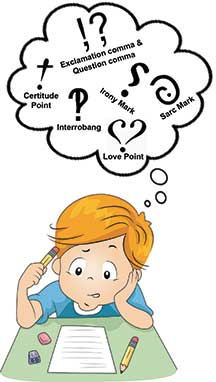Divya Choudary
Ever wondered what life in the social network era would be like without the exclamation mark? Or whether readers have gotten the tone you had intended?
Just like garnishing, punctuation marks add that little extra to the written word. The exclamation mark highlights the phrase. The comma adds that much needed pause. And the ellipsis seems to signify that there’s a lot more to be said than what has been printed. Just as that one word conveys precisely what you intend to say, the ‘right’ punctuation mark conveys the precise tone. You have to agree that a page dotted with commas and other punctuation marks is definitely more inviting to read. And when you write, don’t you feel that typing a period gives you a sense of completion?
When I started learning Spanish, it was interesting to note that writers could give you a heads-up about the upcoming phrase by using pairs of question ? or exclamation ! marks (one inverted and one right-side up) to set off the text. It definitely helped me adopt the right tone when reading out loud.
 Using punctuation marks can be both fun and challenging. So imagine my excitement when my colleague showed me an article about ‘little know punctuation marks we should be using’. There were a few that I knew, at once, that I’d like to use. For those times when one exclamation mark was insufficient there was the certitude point – a symbol for unwavering conviction and certainty. For those moments I was excited and inquisitive and didn’t want to end the sentence, there were the exclamation comma and the question comma. These, like the ones we currently use, would improve readability too!
Using punctuation marks can be both fun and challenging. So imagine my excitement when my colleague showed me an article about ‘little know punctuation marks we should be using’. There were a few that I knew, at once, that I’d like to use. For those times when one exclamation mark was insufficient there was the certitude point – a symbol for unwavering conviction and certainty. For those moments I was excited and inquisitive and didn’t want to end the sentence, there were the exclamation comma and the question comma. These, like the ones we currently use, would improve readability too!
The others, however, seemed to be trying too hard. Do we really need a ‘love point’ to denote affection? Or punctuation marks to distinguish between sarcasm and irony, for the reader to catch on? Also, wouldn’t a ‘sarcmark ’ to signify sarcasm, defeat the purpose of sarcasm?
Texting and instant messaging have changed the way we use punctuation. The exclamation mark, unsurprisingly, is the most overused punctuation mark today. It no longer connotes remarkable excitement, but functions as a symbol of the everyday. If you’re excited use multiple exclamation marks to show it. Yay!!! Surprised? Then use a question mark followed by an exclamation point, like in “Really?!”, or the interrobang. And if punctuation marks don’t do it for you, you could always resort to emoticons. 🙂 For these, unlike the “little know punctuation marks”, you wouldn’t even need to look beyond the standard character set on your keyboard.
While we need more evocative punctuation marks to deal with communication that has become concise, if we can’t find the right words to convey the meaning, would punctuation marks help at all? So, while I am comfortable reading and writing IM lingo on my phone, and do agree that we could use tweaked punctuation on facebook, when it comes to reading books, old school grammar and punctuation is what I’d rather have – text in which dashes and hyphens are in their right places and words that provide the depth themselves.
